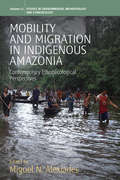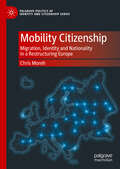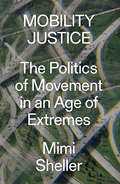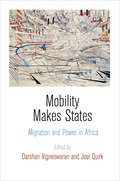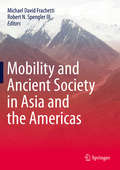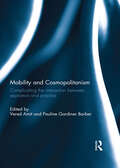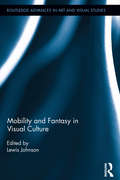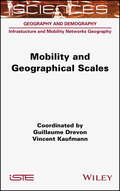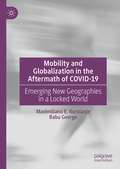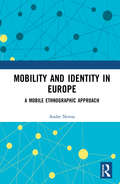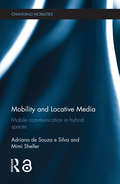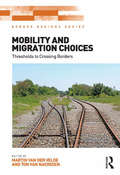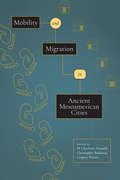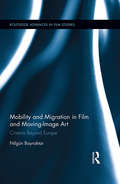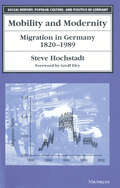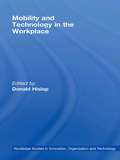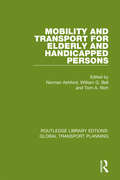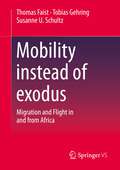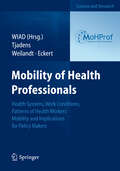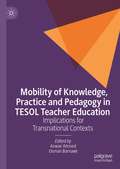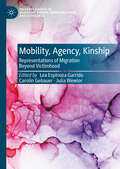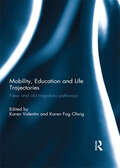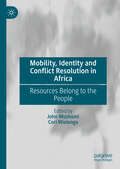- Table View
- List View
Mobility And Migration In Asian Pacific Higher Education
by Deane E. Neubauer Kazuo KurodaThrough case studies in eight Asian countries, Europe, and the United States, this volume explores the range and consequences of increased mobility within Asia-Pacific higher education and the patterns of migration emerging for persons, ideas, institutions, and practices.
Mobility And Migration In Indigenous Amazonia
by Miguel N. AlexiadesContrary to ingrained academic and public assumptions, wherein indigenous lowland South American societies are viewed as the product of historical emplacement and spatial stasis, there is widespread evidence to suggest that migration and displacement have been the norm, and not the exception. This original and thought-provoking collection of case studies examines some of the ways in which migration, and the concomitant processes of ecological and social change, have shaped and continue to shape human-environment relations in Amazonia. Drawing on a wide range of historical time frames (from pre-conquest times to the present) and ethnographic contexts, different chapters examine the complex and important links between migration and the classification, management, and domestication of plants and landscapes, as well as the incorporation and transformation of environmental knowledge, practices, ideologies and identities.
Mobility Citizenship: Migration, Identity and Nationality in a Restructuring Europe (Palgrave Politics of Identity and Citizenship Series)
by Chris MorehThis book aims to trace the development of a new conception of ‘mobility citizenship’ in Europe historically, demographically and experientially. To this aim, it adopts a ‘constellationist’ approach applied to the intra-European mobility space and uses the case studies of Hungarian and Romanian migration to the United Kingdom to develop a multidimensional meso-level comparative empirical analysis of mobility-citizenship constellations. The main theoretical proposition of the book is that citizenship has undergone a noticeable change in meaning and valuation, with mobility rights becoming a more central component in the structure of opportunities it provides citizens. The logic of ‘mobility citizenship’ is thus changing long-held perceptions around the social functions of citizenship, and consequently, the nature of contemporary transnational society. The multifaceted analysis presented in the book will appeal to readers with backgrounds in various disciplines such as political sociology, migration studies, citizenship studies, nationalism studies, or European studies.
Mobility Justice: The Politics of Movement in an Age of Extremes
by Mimi ShellerMobility justice is one of the crucial political and ethical issues of our dayWe are in the midst of a global climate crisis and experiencing the extreme challenges of urbanization. In Mobility Justice, Mimi Sheller makes a passionate argument for a new understanding of the contemporary crisis of movement.Sheller shows how power and inequality inform the governance and control of movement. She connects the body, street, city, nation, and planet in one overarching theory of the modern, perpetually shifting world. Concepts of mobility are examined on a local level in the circulation of people, resources, and information, as well as on an urban scale, with questions of public transport and “the right to the city.” On the planetary level, she demands that we rethink the reality where tourists and other elites are able to roam freely, while migrants and those most in need are abandoned and imprisoned at the borders.Mobility Justice is a new way to understand the deep flows of inequality and uneven accessibility in a world in which the mobility commons have been enclosed. It is a call for a new understanding of the politics of movement and a demand for justice for all.
Mobility Makes States: Migration and Power in Africa
by Joel Quirk Darshan VigneswaranHuman mobility has long played a foundational role in producing state territories, resources, and hierarchies. When people move within and across national boundaries, they create both challenges and opportunities. In Mobility Makes States, chapters written by historians, political scientists, sociologists, and anthropologists explore different patterns of mobility in sub-Saharan Africa and how African states have sought to harness these movements toward their own ends.While border control and intercontinental migration policies remain important topics of study, Mobility Makes States demonstrates that immigration control is best understood alongside parallel efforts by states in Africa to promote both long-distance and everyday movements. The contributors challenge the image of a fixed and static state that is concerned only with stopping foreign migrants at its border, and show that the politics of mobility takes place across a wide range of locations, including colonial hinterlands, workplaces, camps, foreign countries, and city streets. They examine short-term and circular migrations, everyday commuting and urban expansion, forced migrations, emigrations, diasporic communities, and the mobility of gatekeepers and officers of the state who push and pull migrant populations in different directions. Through the experiences and trajectories of migration in sub-Saharan Africa, this empirically rich volume sheds new light on larger global patterns and state making processes.Contributors: Eric Allina, Oliver Bakewell, Pamila Gupta, Nauja Kleist, Loren B. Landau, Joel Quirk, Benedetta Rossi, Filipa Ribeiro da Silva, Simon Turner, Darshan Vigneswaran.
Mobility and Ancient Society in Asia and the Americas
by Michael David Frachetti Robert N. Spengler IIIMobility and Ancient Society in Asia and the Americas contains contributions by leading international scholars concerning the character, timing, and geography of regional migrations that led to the dispersal of human societies from Inner and northeast Asia to the New World in the Upper Pleistocene (ca. 20,000-15,000 years ago). This volume bridges scholarly traditions from Europe, Central Asia, and North and South America, bringing different perspectives into a common view. The book presents an international overview of an ongoing discussion that is relevant to the ancient history of both Eurasia and the Americas. The content of the chapters provides both geographic and conceptual coverage of main currents in contemporary scholarly research, including case studies from Inner Asia (Kazakhstan), southwest Siberia, northeast Siberia, and North and South America. The chapters consider the trajectories, ecology, and social dynamics of ancient mobility, communication, and adaptation in both Eurasia and the Americas, using diverse methodologies of data recovery ranging from archaeology, historical linguistics, ancient DNA, human osteology, and palaeoenvironmental reconstruction. Although methodologically diverse, the chapters are each broadly synthetic in nature and present current scholarly views of when, and in which ways, societies from northeast Asia ultimately spread eastward (and southward) into North and South America, and how we might reconstruct the cultures and adaptations related to Paleolithic groups. Ultimately, this book provides a unique synthetic perspective that bridges Asia and the Americas and brings the ancient evidence from both sides of the Bering Strait into common focus.
Mobility and Cosmopolitanism: Complicating the interaction between aspiration and practice
by Vered Amit and Pauline Gardiner BarberIn academic descriptions of cosmopolitanism, one particularly important distinction often recurs. Specifically, scholars have been concerned to distinguish between cosmopolitanism as a set of mundane practices and/or competences on the one hand and cosmopolitanism as a cultivated form of consciousness or moral aspiration on the other. For anthropologists whose ethnographic studies reveal many different expressions of cosmopolitanism, this distinction between aspiration and practice can often be quite ambiguous. This book therefore brings together five contributions from anthropologists who are reporting on encounters and aspirations that reveal different forms of spatial mobility, scales of commitment or risk, and are often transient, ambivalent and precarious. These are circumstances in which cosmopolitanism emerges as uneven and partial rather than as a comprehensive or unequivocal transformation of practice and outlook.This book was originally published as a special issue of Identities: Global Studies in Culture and Power.
Mobility and Fantasy in Visual Culture (Routledge Advances in Art and Visual Studies)
by Lewis JohnsonThis volume offers a varied and informed series of approaches to questions of mobility—actual, social, virtual, and imaginary—as related to visual culture. Contributors address these questions in light of important contemporary issues such as migration; globalization; trans-nationality and trans-cultural difference; art, space and place; new media; fantasy and identity; and the movement across and the transgression of the proprieties of boundaries and borders. The book invites the reader to read across the collection, noting differences or making connections between media and forms and between audiences, critical traditions and practitioners, with a view to developing a more informed understanding of visual culture and its modalities of mobility and fantasy as encouraged by dominant, emergent, and radical forms of visual practice.
Mobility and Geographical Scales
by Vincent Kaufmann Guillaume DrevonThe concept of mobility has grown enormously over the last two decades. A large part of the social sciences has been interested in the different forms of mobility, from a wide variety of spatial and temporal scales. This book presents the different spatial and temporal scales of mobility and the way in which they form a system, by associating them with essential and original research objects. It provides an in-depth review of scientific knowledge, a perspective on major societal issues, analytical tools and a discussion on the main current academic debates. The authors highlight the need to take into account both the spatial and temporal scales of mobility in order to address contemporary environmental and societal issues. The book invites us to think about the entanglement of these different scales from the analysis of rhythms by founding a rhythmology of contemporary mobilities.
Mobility and Globalization in the Aftermath of COVID-19: Emerging New Geographies in a Locked World
by Maximiliano E. Korstanje Babu GeorgeThis book argues that COVID-19 revives a much deeper climate of terror which was instilled by terrorism and the War on Terror originally declared by Bush's administration in 2001. It discusses critically not only the consequences of COVID-19 on our daily lives but also “the end of hospitality”, at least as we know it.Since COVID-19 started spreading across the globe, it affected not only the tourism industry but also ground global trade to a halt. Governments adopted restrictive measures to stop the spread of the virus, including the closure of borders, and airspace, the introduction of strict lockdowns and social distancing, much of which led to large-scale cancellations of international and domestic flights. This book explores how global tourists, who were largely considered ambassadors of democratic and prosperous societies in the pre-pandemic days, have suddenly become undesired guests.
Mobility and Identity in Europe: A Mobile Ethnographic Approach
by Andre NovoaThis book demonstrates that mobility in Europe is not a synonym for European mobility, showing how certain mobile individuals are more likely to develop an explicitly European identity than others. Through a series of mobile ethnographic accounts with truck drivers, musicians and MEPs, the author lays out the complexities behind assumptions about mobility and European identity, providing a clear contrast between individuals for whom this process certainly is true and others who, in spite of their high levels of mobility, do not consider themselves European, or for whom the notion of being European is simply insignificant. Ultimately, as this book shows, the enactment of a European identity, through practices of mobility, has more to do with social class than with a mobile condition per se, with mobility in Europe being transformed into European mobility only when it empowers individuals, solidifying their elevated position in the social pyramid. An account of European identity and its connection to mobility and notions of class, Mobility and Identity in Europe also explores the ways in which mobile ethnography can be practised as a method and what conclusions can be drawn from it. As such, it will appeal to scholars and students of sociology, anthropology and geography.
Mobility and Locative Media: Mobile Communication in Hybrid Spaces (Changing Mobilities)
by Mimi Sheller Adriana de Souza e SilvaMobilities has become an important framework to understand and analyze contemporary social, spatial, economic and political practices. Especially as mobile media become seamlessly integrated into transportation networks, navigating urban spaces, and connecting with social networks while on the move, researchers need new approaches and methods to bring together mobilities with mobile communication and locative media. Mobile communication scholars have focused on cell phones, often ignoring broader connections to urban spaces, geography, and locational media. As a result, they emphasized virtual mobility and personalized communication as a way of disconnecting from place, location and publics. The growing pervasiveness of location-aware technology urges us to rethink the intersection among location, mobile technologies and mobility. Few studies have addressed the many transformations taking place in mobile sociality and in urban spatial processes through the appropriation of these technologies. Chapter 12 of this book is freely available as a downloadable Open Access PDF under a Creative Commons Attribution-Non Commercial-No Derivatives 3.0 license. https://s3-us-west-2.amazonaws.com/tandfbis/rt-files/docs/Open+Access+Chapters/9781138778139_oachapter12.pdf
Mobility and Migration Choices: Thresholds to Crossing Borders (Border Regions Series)
by Ton van Naerssen Martin van VeldeThe crossing of national state borders is one of the most-discussed issues of contemporary times and it poses many challenges for individual and collective identities. This concerns both short-distance mobility as well as long-distance migration. Choosing to move - or not - across international borders is a complex decision, involving both cognitive and emotional processes. This book tests the approach that three crucial thresholds need to be crossed before mobility occurs; the individual’s mindset about migrating, the choice of destination and perception of crossing borders to that location and the specific routes and spatial trajectories available to get there. Thus both borders and trajectories can act as thresholds to spatial moves. The threshold approach, with its focus on processes affecting whether, when and where to move, aims to understand the decision-making process in all its dimensions, in the hope that this will lead to a better understanding of the ways migrants conceive, perceive and undertake their transnational journeys. This book examines the three constitutive parts discerned in the cross-border mobility decision-making process: people, borders and trajectories and their interrelationships. Illustrated by a global range of case studies, it demonstrates that the relation between the three is not fixed but flexible and that decision-making contains aspects of belonging, instability, security and volatility affecting their mobility or immobility.
Mobility and Migration in Ancient Mesoamerican Cities
by Christopher Beekman M. Charlotte Arnauld Grégory PereiraMobility and Migration in Ancient Mesoamerican Cities is the first focused book-length discussion of migration in central Mexico, west Mexico and the Maya region, presenting case studies on population movement in and among Classic, Epiclassic, and Postclassic Mesoamerican societies and polities within the framework of urbanization and de-urbanization. Looking beyond the conceptual dichotomy of sedentism versus mobility, the contributors show that mobility and migration reveal a great deal about the formation, development, and decline of town- and city-based societies in the ancient world. In a series of data-rich chapters that address specific evidence for movement in their respective study areas, an international group of scholars assesses mobility through the isotopic and demographic analysis of human remains, stratigraphic identification of gaps in occupation, and local intensification of water capture in the Maya lowlands. Others examine migration through the integration of historic and archaeological evidence in Michoacán and Yucatán and by registering how daily life changed in response to the influx of new people in the Basin of Mexico. Offering a range of critical insights into the vital and under-studied role that mobility and migration played in complex agrarian societies, Mobility and Migration in Ancient Mesoamerican Cities will be of value to Mesoamericanist archaeologists, ethnohistorians, and bioarchaeologists and to any scholars working on complex societies. Contributors: Jaime J. Awe, Meggan Bullock, Sarah C. Clayton, Andrea Cucina, Véronique Darras, Nicholas P. Dunning, Mélanie Forné, Marion Forest, Carolyn Freiwald, Elizabeth Graham, Nancy Gonlin, Julie A. Hoggarth, Linda Howie, Elsa Jadot, Kristin V. Landau, Eva Lemonnier, Dominique Michelet, David Ortegón Zapata, Prudence M. Rice, Thelma N. Sierra Sosa, Michael P. Smyth, Vera Tiesler, Eric Weaver
Mobility and Migration in Film and Moving Image Art: Cinema Beyond Europe (Routledge Advances in Film Studies)
by Nilgun BayraktarMobility and Migration in Film and Moving Image Art explores cinematic and artistic representations of migration and mobility in Europe from the 1990s to today. Drawing on theories of migrant and diasporic cinema, moving-image art, and mobility studies, Bayraktar provides historically situated close readings of films, videos, and cinematic installations that concern migratory networks and infrastructures across Europe, the Middle East, and Africa. Probing the notion of Europe as a coherent entity and a borderless space, this interdisciplinary study investigates the ways in which European ideals of mobility and fluidity are deeply enmeshed with forced migration, illegalization, and xenophobia. With a specific focus on distinct forms of mobility such as labor migration, postcolonial migration, tourism, and refugee mobilities, Bayraktar studies the new counter-hegemonic imaginations invoked by the work of filmmakers such as Ayşe Polat, Fatih Akin, Michael Haneke, and Tony Gatlif as well as video essays and installations of artists such as Kutluğ Ataman, Ursula Biemann, Ergin Çavuşoğlu, Maria Iorio and Raphaël Cuomo. Challenging aesthetic as well as national, cultural, and political boundaries, the works central to this book envision Europe as a diverse, inclusive, and unfixed continent that is reimagined from many elsewheres well beyond its borders.
Mobility and Modernity: Migration in Germany, 1820-1989 (Social History, Popular Culture, And Politics In Germany)
by Steven Lawrence HochstadtMobility and Modernity uses voluminous German data on migrations over the past two centuries to demonstrate why conventional assumptions about the relationship between mobility and modernity must be revised. Thus far the changing total volume of migration has not been traced over a long period for any country. Unique migration registration statistics, both detailed and broadly geographical in coverage, allow the precise plotting of migration rates in Germany since 1820. Steve Hochstadt combines careful quantitative methods, easily understood numerical data, and social analysis based upon broad reading in German social history to show that current beliefs about the direction and timing of changes in German mobility, which have been based on late nineteenth-century anxieties about urbanization and industrialization, do not match the data. Migration rates in Germany rose continuously throughout the nineteenth century, and have fallen during the twentieth century. Mobility, Hochstadt argues, was not an unprecedented accompaniment to industrialization, but a traditional rural response to specific economic changes. Hochstadt's more precise analysis of urban in- and outmigration shows the mechanism of urbanization to have been the migration of families rather than the much greater, but also more circular, migration of single men and women. Hochstadt demonstrates the importance of examining historical behavior, powerfully justifying the methods of historical demography as a path to social understanding. The data and specific conclusions are German, but the methods and reinterpretaion of migration history have much wider application, both to other modern European nations and to currently developing countries. Those who study the modern social history of Europe, the mechanisms that formed urban working classes, and the methods of historical demography will be interested in Hochstadt's work.
Mobility and Technology in the Workplace
by Donald HislopThe contemporary period has witnessed the rapid evolution in a wide range of mobile technology. This book charts the profound implications these technological changes have for workers and business organizations. From an organizational point of view they have the potential to transform the nature of organizations, through allowing workers to be incr
Mobility and Territoriality: Social and Spatial Boundaries among Foragers, Fishers, Pastoralists and Peripatetics
by Michael J. CasimirTerritorial behaviour among various herders and hunter-gatherers has been discussed in earlier studies, but this is the first time that a comparison of these three types of mobile populations has been attempted. The original papers presented in this volume discuss the conditions and problems of securing access to resources among pastoralists, peripatetics, and hunting, gathering and fishing communities in Africa, Asia, Europe and the Middle East. A comprehensive introductory chapter places these empirical studies in a broader theoretical context of the behaviourial sciences.
Mobility and Transport for Elderly and Handicapped Persons (Routledge Library Edtions: Global Transport Planning #4)
by Norman Ashford, William G. Bell and Tom A. RichOriginally published in 1982 and contributed to by a range of international authors and experts in the field of transport accessibility, this volume discusses the position of urban and rural transport problems of the elderly and disabled in the UK, USA, Belgium, Canada, France, Germany, The Netherlands and Sweden. Based on research, policy analysis and documental field experience the volume also discusses advances made in relevant technology, major changes in public policy and innovative proposals for system development or change.
Mobility instead of exodus: Migration and Flight in and from Africa
by Thomas Faist Tobias Gehring Susanne U. SchultzAfrica is commonly regarded as a "continent on the move" in scholarly observation and mass media reportage. Movement is seen primarily in the direction of Europe. Yet the public debate is characterized by two misconceptions. The first is that high population growth in Africa would almost automatically trigger higher international migration to the neighbouring European continent. There is even talk of a "rush to Europe". The second frequently encountered misconception is that migration and flight in and from Africa is primarily a result of poverty, violent conflicts and environmental degradation. Both are misconceptions that cannot be reconciled with the facts at hand.
Mobility of Health Professionals
by Wissenschaftliches Institut Der Frits Tjadens Josef Eckert Caren WeilandtThis book on mobility of health professionals reviews, analyses and summarises published information and data as well as collected interview data from stake holders, including politicians, policy makers, health service managers and migrant health workers. It is based on the research carried out under the umbrella of the EU-funded project "Mobility of Health Professionals (MoHProf). The partners involved in the MoHProf project gathered evidence from 25 countries around basic questions and knowledge gaps relating to the international migration of health professionals, which involved an analysis of migration flows and evaluation of policies addressing migration. This book provides a comprehensive description and analysis of the mobility streams, the motives and driving forces behind them and the impact on and challenges for health systems and draws conclusions and provides recommendations for future strategic planning, monitoring and the management of mobility of health professionals as well as further research and policy development needs.
Mobility of Knowledge, Practice and Pedagogy in TESOL Teacher Education: Implications for Transnational Contexts
by Anwar Ahmed Osman BarnawiThis edited book brings together chapters from diverse geographical and educational contexts to examine the question of transnationalism in English Language teacher education. While the activities that connect people, institutions and cultural practices across the borders of nation-states have gained interest in fields such as applied linguistics, TESOL and migration studies in recent years, there has been little research so far into how transnationalism intersects with language teacher education, and how existing practices can be better integrated into teacher education programmes. The authors fill this gap by introducing and examining existing transnational practices - including cross-cultural settings, study abroad programmes and online teacher education - then offering multiple dialogues on mobility of knowledge, practice and pedagogy in teacher education. This book will be of interest to language teachers, teacher educators, and students and scholars of applied linguistics, cross-cultural studies, and migration studies.
Mobility, Agency, Kinship: Representations of Migration Beyond Victimhood (Palgrave Studies in Mediating Kinship, Representation, and Difference)
by Lea Espinoza Garrido Carolin Gebauer Julia WewiorThis volume offers new perspectives on the ways in which migrants use storytelling practices and kinship formations in order to navigate and modify spaces of sovereignty, and thus to re-write narratives portraying them as helpless and passive victims. It provides one of the first investigations that assembles multidisciplinary contributions to look beyond individual acts of migrant agency and toward the entanglements of individual and collective agency, formations of kinship structures, and feelings, expressions, and representations of community and (multiple) belonging(s). The contributions explore the interplay between agency, kinship, and migration from various fields, including sociology, psychology, philosophy, border studies, gender and queer studies, postcolonial studies, ecocriticism, film and media studies, and literary and cultural studies – with a special focus on interdisciplinary narrative theory. They address real and imagined assertions of migrant agency and kinship formations; draw on empirical research, interviews, and accounts of lived experiences; and analyze the role of narrative, media, and technologies in artistic, literary, and cinematic representations of migrant agency and kinship. By probing migrant identity discourses in different cultural and medial contexts, the contributions examine how narratives negotiate and challenge the unequal distribution of mobility, resources, and vulnerability that preconfigures many migrant lives; they also discuss narrative devices, storytelling techniques, and other representational strategies that migrants employ, as well as technologies that they draw on, to lay powerful claims on space and citizenship and to eschew established scripts of victimhood. As such, the volume addresses and embraces the tensions between vulnerability and agency that come to the fore when we try to understand the different ways in which migrants shape, and are shaped by, their (trans)local, material, economic, affective, social, cultural, and political realities.
Mobility, Education and Life Trajectories: New and old migratory pathways
by Karen Valentin and Karen Fog OlwigMigration for educational purposes, once the privilege of the upper class, has become a global mass phenomenon in recent years. This volume examines, within different cultural and historical contexts, the close relationship between migration, education, and social mobility. Adopting the perspective that education includes a broad range of formative experiences, the chapters explore different educational trajectories and the local, regional, and transnational relations in which they are embedded. Three key issues emerge from the analyses: firstly, the central role of temporal aspects in terms of both the overall historical conditions and the specific biographical circumstances shaping educational opportunities; secondly, the complex agendas informing individuals’ migration and the adjustment of these agendas in the light of the vagaries of migrant life; and thirdly, the importance of migrants’ self-perception as ‘educated persons’, and the invention of new identities, and the maintaining of old identities that this involves. This book was originally published as a special issue of Identities: Global Studies in Culture and Power.
Mobility, Identity and Conflict Resolution in Africa: Resources Belong to the People
by Cori Wielenga John MushomiThis volume examines land and resource contestations in the East African Albertine region, where Uganda, the Democratic Republic of Congo, Rwanda, Burundi and Tanzania intersect. It is one of the most biodiverse regions on the continent, and became highly contested when Uganda discovered oil there in 2006. The resource contestation in this region has resulted in ongoing conflict, and has defined and re-defined identity and citizenship. Contributors of this volume succinctly bring out the major forces that have been responsible for resource contestations and conflicts together with an emphasis on the existing mechanisms for peaceful co-existence, particularly in relation to alternative dispute resolution mechanisms within indigenous knowledge systems.

